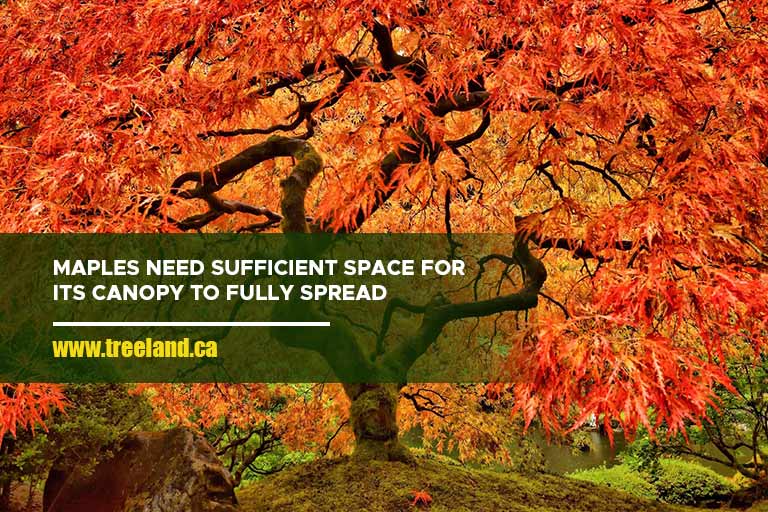When buying a maple tree for your landscape, making the right choices is essential for its long-term health and growth. From selecting the right species to ensuring proper care, there are several factors that can make or break your investment. To help you avoid costly errors, here are the most common mistakes to watch out for when purchasing a maple tree.
Mistake #1: Ignoring the Local Climate
One of the biggest mistakes when buying a maple tree is failing to consider your local climate. Not all maple trees thrive in the same conditions, and choosing a species that isn’t suited to your region can lead to stunted growth or even the tree’s failure to survive.
For instance, sugar maples prefer cooler climates and may struggle in areas with extreme heat, while red maples are more tolerant of warmer temperatures.
To avoid this mistake, research which species are native or adaptable to your area’s weather patterns. Understanding factors like temperature extremes, rainfall, and frost dates can help ensure that your new maple tree will flourish in its new environment. Always consult a local expert or nursery for advice on the best maple varieties for your climate.
Mistake #2: Not Considering Soil Type
Overlooking soil type is a common mistake when purchasing a maple tree. Different maple species have specific soil preferences, and planting in unsuitable soil can negatively impact the tree’s growth and health. For example, Japanese maples thrive in well-drained, slightly acidic soils, while silver maples can tolerate wetter conditions.
- Soil Tests
To ensure a successful planting, start by testing your soil. Conduct a soil test to assess pH levels, nutrient content, and drainage capacity. This information will guide you in selecting the right maple species for your landscape.
Ideally, maple trees prefer a soil pH between 6.0 and 7.5. If your soil is too acidic or alkaline, you may need to amend it with lime or sulphur to achieve the desired levels.
- Soil Texture
The texture of the soil also plays a critical role in a tree’s health. Sandy soils drain quickly and may not retain enough moisture for certain maple species, while clay soils can become compacted and retain too much water. To enhance drainage in clay-heavy soils, consider mixing in organic matter such as compost or peat moss to improve aeration and water retention.
- Drainage
Another crucial aspect is to assess the drainage of your planting site. Poor drainage can lead to root rot, particularly in species like bigtooth maples, which prefer consistent moisture without standing water. Conduct a simple drainage test by digging a hole about 30 centimetres deep and filling it with water.
If the water drains away within a few hours, your site has adequate drainage; if it remains for a longer period, consider choosing a different location or amending the soil to improve drainage.
- Compacted Soil
Soil that is compacted can severely restrict root expansion, limiting the tree’s ability to absorb water and nutrients. If your planting area has heavy foot traffic or is near driveways, you may need to aerate the soil or choose a different spot for planting.
- Long-Term Soil Management
Long-term soil management is also vital for the health of your maple tree. Regularly add organic mulch around the base of the tree to maintain moisture, suppress weeds, and improve soil structure as it breaks down. Additionally, periodic soil testing every few years can help you monitor pH and nutrient levels, allowing for timely amendments that promote healthy growth.
Mistake #3: Buying Based on Appearance Alone
Many buyers make the mistake of selecting a maple tree solely for its appearance, without considering factors that impact its long-term health and suitability. While vibrant fall colours or unique leaf shapes might stand out, it’s essential to think beyond aesthetics.
Factors like growth rate, mature size, and the tree’s ability to adapt to your local environment are crucial when making a decision.
Mistake #4: Overlooking Tree Size and Space Requirements
One significant oversight when purchasing a maple tree is failing to consider the tree’s mature size and the space it will require to grow. Each species of maple can vary greatly in height and spread, and planting a tree too close to structures, other trees, or utility lines can lead to future problems.
- Mature Size
Before making a purchase, it’s essential to research the mature size of the specific maple species you are considering. For example, a sugar maple can grow up to 24 meters tall with a spread of 15 meters, while a Japanese maple may reach only 3 to 6 meters in height.
Understanding the mature size will help you select the right tree for your landscape, ensuring it fits well within the available space without causing overcrowding.
- Root Expansion
In addition to height and spread, consider the root system of the tree. Maple trees typically have extensive root systems that require adequate space to expand. Planting too close to foundations, driveways, or sidewalks can lead to root damage and structural issues over time. As a general guideline, the planting hole should be at least twice the width of the root ball to allow for healthy root development.
- Canopy Growth

Maples can also have wide canopies that need room to spread. If you plant a tree too close to other trees or structures, it may not develop properly, leading to an unbalanced shape or stunted growth. This can also create competition for sunlight and nutrients, making it challenging for your maple to thrive.
- Proximity to Structures
Consider the proximity of the tree to buildings, fences, and other features in your landscape. A tree planted too close to a house may cause damage to roofing or siding as it grows. Additionally, the shade cast by a large tree can impact the growth of nearby plants and flowers, limiting their exposure to sunlight.
- Future Growth
When planting, think long-term. Trees take years to mature, and what may seem like a suitable space now could become crowded over time. Leave enough room for the tree to grow both vertically and horizontally, as well as for maintenance tasks like pruning or watering.
- Site Planning and Layout
Finally, consider creating a site plan for your garden or landscape. Visualizing where each tree will be located in relation to other plants and structures can help you make informed decisions. Mark out potential planting spots to assess their suitability before making a final choice.
Mistake #5: Neglecting Long-Term Care Needs
Another common oversight when buying a maple tree is neglecting to understand its long-term care requirements. Each species of maple has specific needs for watering, pruning, and fertilizing that are crucial for its health and longevity.
For instance, bigtooth maples require consistent moisture, especially during their early years, while Japanese maples thrive in well-drained soil and can be sensitive to overwatering.
Layering is an effective method for propagating bigtooth maple trees, but root rot can be a concern. If the conditions are too damp or poorly drained, it can lead to serious issues for the tree (Rupp et al., 2021).
Before making a purchase, consider how much time and effort you’re willing to invest in caring for your tree. Some species, like the silver maple, are relatively low-maintenance, while others may require more attention and specialized care.
Understanding these needs will help you avoid future issues, such as nutrient deficiencies or pest infestations, ensuring your maple tree grows strong and healthy for years to come.
Mistake #6: Choosing the Wrong Season for Planting
Selecting the wrong season for planting a maple tree can lead to poor establishment and growth. Many buyers are unaware that timing is crucial for ensuring a tree takes root effectively. Planting during extreme temperatures (either too hot in the summer or too cold in the winter) can stress the tree and inhibit its ability to thrive.
The ideal time to plant most maple trees is in early spring or fall when temperatures are milder, allowing for better root development before the heat of summer or the chill of winter sets in. In contrast, planting during the height of summer can cause the tree to struggle with heat stress, while winter planting may expose it to freezing conditions that can damage young roots.
Mistake #7: Failing to Research Reputable Sources

A critical mistake many buyers make is failing to research reputable sources when purchasing a maple tree. Not all nurseries or tree farms provide high-quality trees, and purchasing from unreliable sources can lead to a host of problems, such as unhealthy trees, pest infestations, or incorrect species.
For example, when looking for trees for sale in Stouffville, it’s essential to choose a nursery known for its quality stock and good practices.
Visiting the nursery in person can allow you to inspect the trees for signs of health, such as vibrant leaves and strong trunks. Additionally, knowledgeable staff can provide valuable insights about the specific care needs of the tree you’re interested in.
Mistake #8: Ignoring Pest and Disease Resistance
One often-overlooked factor when purchasing a maple tree is the importance of pest and disease resistance. Many buyers focus primarily on aesthetics and growth habits, neglecting to consider how susceptible the species is to common pests and diseases.
Certain maple varieties are more prone to issues like aphids, scale, or fungal infections, which can significantly impact their health and longevity.
For instance, while a particular maple tree might look stunning in your lawn, if it is known to attract pests or is vulnerable to diseases like verticillium wilt, it could lead to ongoing maintenance challenges and potential tree loss. Before making a purchase, research the pest and disease resistance of the specific maple species you’re considering.
Your Perfect Maple Awaits
Avoiding these common mistakes when purchasing maple trees will set you on the path to a thriving landscape. With careful planning and consideration, you can enjoy the beauty and benefits of your chosen maple for years to come.
If you’re looking for quality maple trees for sale in Toronto, Caledon Treeland is here to help! Contact us at (905) 880-1828 to find the perfect tree for your garden. Let’s create a stunning outdoor space together!

